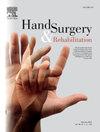Hamate autograft for proximal pole scaphoid fracture: A systematic review
IF 1
4区 医学
Q4 ORTHOPEDICS
引用次数: 0
Abstract
Background
Proximal pole scaphoid fracture is not uncommon and present therapeutic challenges due to impaired perfusion, with risk of secondary non-union, avascular necrosis and wrist degeneration. There is no consensus on surgical techniques for a non-salvageable proximal pole, but proximal hamate autograft to resurface the scaphoid is gaining interest. This systematic review assesses the evidence for proximal hamate autograft in resurfacing non-salvageable scaphoid proximal poles.
Methods
A systematic review searched the Medline, Embase, PubMed and Scopus databases for the period 2000–2024, following PRISMA guidelines. The protocol was registered with PROSPERO. Risk of bias was measured using ROBINS-I (Risk Of Bias In Non-randomized Studies - of Interventions).
Results
Mean duration of non-union at presentation was 50.8 months (n = 10), with a mean follow-up of 15.7 months (n = 10). Mean hamate graft length was 6.7 mm (n = 26). Radiographic union was achieved in 93.3% of patients (n = 30), at a mean 10.6 weeks (n = 26). Mean postoperative wrist flexion-extension was 89.5° (n = 10), averaging 61.4% of the arc for the contralateral hand (n = 8). Pronation and supination recovered contralateral values (n = 5). Postoperative grip strength in the affected hand was 79.8% of the contralateral value (n = 26). Postoperative QuickDASH score and VAS pain rating averaged 25 (n = 8) and 2 (n = 21), respectively. Five patients (16.7%; n = 30) experienced complications.
Conclusions
Hamate autografting for resurfacing non-salvageable scaphoid proximal poles demonstrated satisfactory early-to-medium-term outcomes. Although promising, more research is necessary to confirm the utility of this treatment modality.
Level of evidence
IV (systematic review).
锤骨自体移植治疗肩胛骨近端骨折:系统综述。
背景:近端肩胛骨骨折并不少见,由于灌注受损,有继发不愈合、血管性坏死和腕关节退化的风险,因此给治疗带来了挑战。对于无法修复的近端肩胛骨的手术技术还没有达成共识,但用近端锤骨自体移植物复位肩胛骨的方法正受到越来越多的关注。本系统性综述评估了近端锤状骨自体移植物用于不可修复的肩胛骨近端再植的证据:按照 PRISMA 指南,系统性综述检索了 Medline、Embase、PubMed 和 Scopus 数据库中 2000-2024 年期间的内容。研究方案已在 PROSPERO 注册。采用ROBINS-I(非随机干预研究中的偏倚风险)对偏倚风险进行了测量:出现非骨髁连接时的平均持续时间为 50.8 个月(10 例),平均随访时间为 15.7 个月(10 例)。平均移植长度为6.7毫米(26人)。93.3%的患者(样本数=30)在平均10.6周(样本数=26)时实现了放射学结合。术后腕关节的平均屈伸角度为89.5°(10人),平均弧度为对侧手(8人)的61.4%。俯卧和仰卧恢复到对侧值(n = 5)。术后患手的握力为对侧值的 79.8%(n = 26)。术后 QuickDASH 评分和 VAS 疼痛评分的平均值分别为 25 分(8 人)和 2 分(21 人)。五名患者(16.7%;n = 30)出现并发症:结论:用Hamate自体移植物重塑不可修复的肩胛骨近端,可获得令人满意的早期至中期疗效。尽管前景广阔,但仍需更多研究来证实这种治疗方式的实用性:IV级(系统综述)。
本文章由计算机程序翻译,如有差异,请以英文原文为准。
求助全文
约1分钟内获得全文
求助全文
来源期刊

Hand Surgery & Rehabilitation
Medicine-Surgery
CiteScore
1.70
自引率
27.30%
发文量
0
审稿时长
49 days
期刊介绍:
As the official publication of the French, Belgian and Swiss Societies for Surgery of the Hand, as well as of the French Society of Rehabilitation of the Hand & Upper Limb, ''Hand Surgery and Rehabilitation'' - formerly named "Chirurgie de la Main" - publishes original articles, literature reviews, technical notes, and clinical cases. It is indexed in the main international databases (including Medline). Initially a platform for French-speaking hand surgeons, the journal will now publish its articles in English to disseminate its author''s scientific findings more widely. The journal also includes a biannual supplement in French, the monograph of the French Society for Surgery of the Hand, where comprehensive reviews in the fields of hand, peripheral nerve and upper limb surgery are presented.
Organe officiel de la Société française de chirurgie de la main, de la Société française de Rééducation de la main (SFRM-GEMMSOR), de la Société suisse de chirurgie de la main et du Belgian Hand Group, indexée dans les grandes bases de données internationales (Medline, Embase, Pascal, Scopus), Hand Surgery and Rehabilitation - anciennement titrée Chirurgie de la main - publie des articles originaux, des revues de la littérature, des notes techniques, des cas clinique. Initialement plateforme d''expression francophone de la spécialité, la revue s''oriente désormais vers l''anglais pour devenir une référence scientifique et de formation de la spécialité en France et en Europe. Avec 6 publications en anglais par an, la revue comprend également un supplément biannuel, la monographie du GEM, où sont présentées en français, des mises au point complètes dans les domaines de la chirurgie de la main, des nerfs périphériques et du membre supérieur.
 求助内容:
求助内容: 应助结果提醒方式:
应助结果提醒方式:


